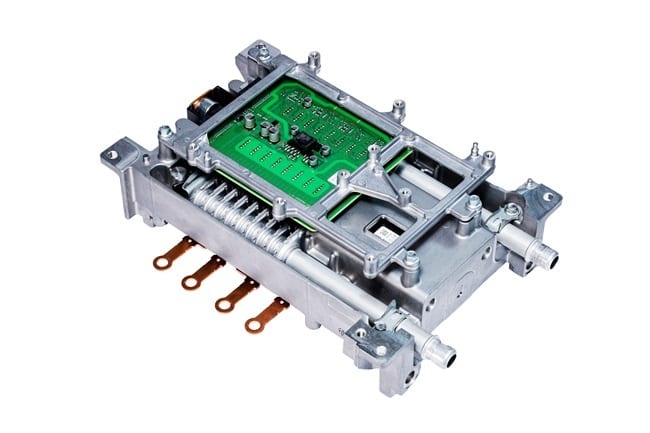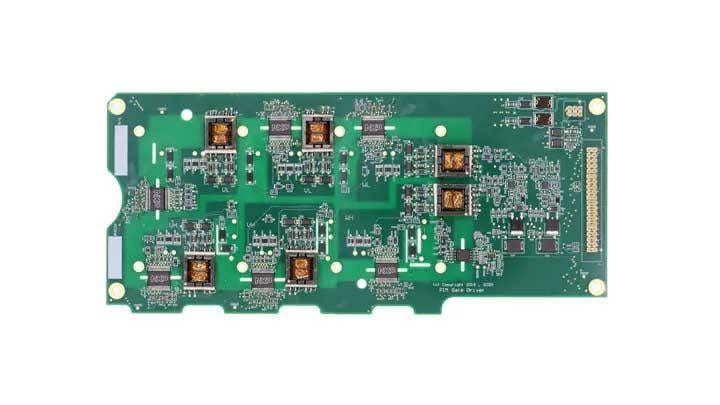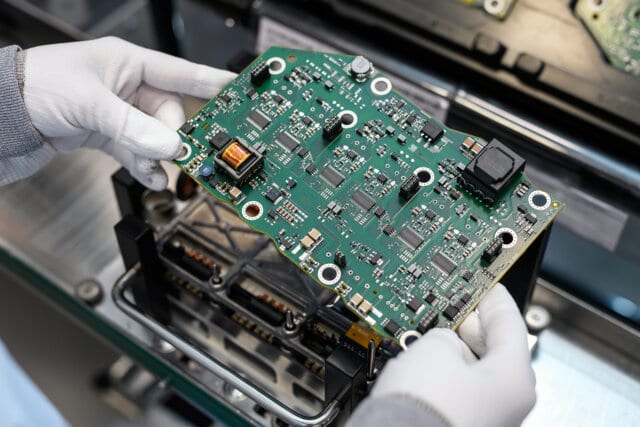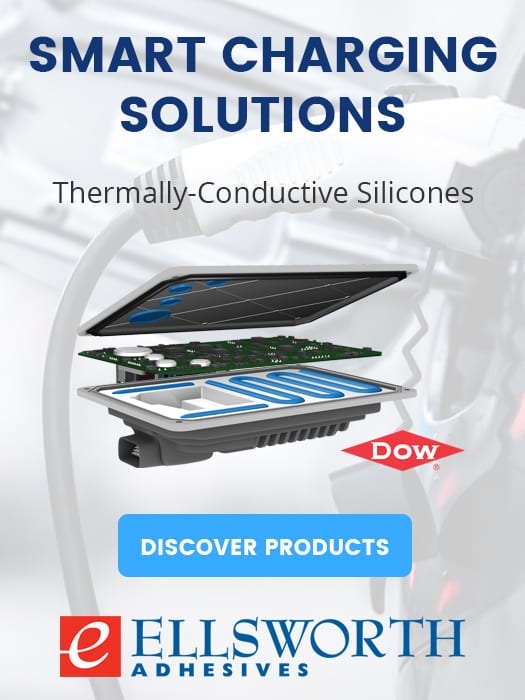Power electronic components generate heat; if they are close to each other, heat can build up. Photo courtesy General Motors
THE BIG PICTURE
POWER ELECTRONICS
Austin Weber // Senior Editor // webera@bnpmedia.com
While batteries and motors are the “lead actors” in electric vehicles, power electronics play an equally important behind-the-scenes role. Vehicle power electronics primarily process and control the flow of electrical energy in EVs. They also control the speed of electric motors and the torque they produce.
In addition, power electronics convert and distribute electrical power to other vehicle systems, such as heating and ventilation, lighting and infotainment. Power electronics components typically include inverters, DC/DC converters and chargers.
Traditionally, the microchips used in power electronics devices were made of ultra-pure silicon. However, this material is increasingly being replaced by silicon carbide (SiC), which offers numerous advantages over pure silicon. For example, silicon carbide semiconductors display better electrical conductivity and enable higher switching frequencies, while also ensuring that much less energy is dissipated in the form of heat.
SiC chips also allow power electronics applications to be operated at much higher temperatures. Power electronics equipped with SiC semiconductors enable longer ranges and faster recharging for EVs.
The U.S. Department of Energy Vehicle Technologies Office (VTO) is involved in a variety of R&D efforts to lower the cost and improve the performance of power electronics used in EVs. Autonomous & Electric Mobility recently asked Steven Boyd, VTO program manager for batteries and electrification, to discuss current trends and issues affecting power electronics.
Power electronics play a key role in electric vehicles. Photo courtesy Continental AG

AEM: Why are power electronics an important piece of the electric vehicle “puzzle”?
Boyd: Power electronics handle and process all of the energy stored in an EV’s battery to provide for necessary functions, including everything from spinning the motors used for vehicle propulsion to powering the air conditioning and radio.
AEM: How can power electronics increase EV range and performance?
Boyd: More efficient power electronics can improve EV range by minimizing losses in power conversion from the battery. Power electronics increase performance by handling higher currents and voltage levels that will provide more power to electric motors.
AEM: What is the latest trend or biggest issue involving EV power electronics?
Boyd: Silicon carbide is already appearing in current EVs. It will be in even more vehicles within a few years. Gallium nitrite is an emerging power semiconductor material that is maturing and may see its first vehicle applications soon. Both of these materials offer benefits such as higher efficiency over existing silicon semiconductor materials. New materials can also play a role in passive power electronic elements such as magnetics and capacitors. Managing the heat removal from power electronics is referred to as thermal management, and new materials can also play a role in improving heat rejection.
AEM: What area of EV power electronics is the most challenging to address?
Boyd: The cost of power electronics and their overall size must be reduced while keeping the efficiencies and lifetimes high. Integration of multiple components in a small package is challenging. There are many different components with individual, dedicated functionality that must all fit close together so they minimize the size and weight of power electronics onboard a vehicle. Power electronic components generate heat; if they are close to each other, their heat affects each other, so taking heat out is an issue to overcome. In addition, capacitors occupy a large volume. It is challenging to reduce their sizes with existing capacitor dielectric materials and production processes.
Power electronics process and control the flow of electrical energy in EVs. Photo courtesy Denso

AEM: How is the U.S. Department of Energy addressing this challenge with its R&D initiatives? Are you and your colleagues focusing on any particular aspect of EV power electronics?
Boyd: Our research focuses on developing revolutionary new power electronics that will leapfrog current on-the-road technologies. The electric drive program supports early-stage R&D for extreme high-power density motors that have the potential to enable radical new architectures by dramatic volume or space reductions and increased durability and reliability. The program’s goal is to develop an electric traction drive system at a cost of $6 per kilowatt for a 100-kilowatt peak system by 2025.
More efficient power electronics can improve EV range by minimizing losses in power conversion from the battery. Photo courtesy NXP Semiconductors

The Electric Drive Technologies Lab Consortium is leveraging U.S. research expertise and national lab facilities to improve the power density of electric drives by 10 timesX compared to 2015, while reducing the cost by 50 percent and doubling lifetime miles within the next five years. The consortium is organized around three [main] projects, including a power electronics keystone. VTO also has multiple projects running in parallel to come up with solutions for all these challenges, starting at the component level.
AEM: Which type of power electronics devices still need to be refined to improve performance or reduce production costs?
Power electronics increase EV performance by handling higher currents and voltage levels. Photo courtesy Continental AG

Boyd: There are some components already available for 800-volt applications, like power semiconductors. We also have to consider the peripheral components, such as capacitors, that will have to be rated for high voltages. For commercial vehicles, the battery voltages might need 1,200-volt power electronics systems. In that case, there will be a need for new components to match these voltage levels, including higher voltage-rated power semiconductors.
AEM: How big an issue is cybersecurity with power electronics? What needs to be done to address this issue?
Boyd: Our efforts related to EV and electric vehicle supply equipment (EVSE) cybersecurity have primarily focused on the interface between the components in the EV charging ecosystem, such as the EV, the EVSE and the grid. While manufacturers have worked to address cybersecurity of their specific products, DOE has identified vulnerabilities with potentially significant consequences that exist in the interface between these products. We are working with stakeholders to develop innovative defense strategies, detection methodologies, and response and recovery solutions to address these vulnerabilities.


